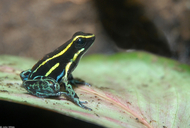|
Hyloxalus azureiventris (Kneller & Henle, 1985)
Sky Blue Poison Dart Frog | family: Dendrobatidae subfamily: Hyloxalinae genus: Hyloxalus |
 © 2008 John White (1 of 2) |
|
|
|
Description Description: This medium-sized frog attains a SVL of 27 mm. The dorsal surface of the body is slightly granular, and the ventral surface is smooth. Maxillary teeth are present, and medial lingual process is absent. The snout is pointed in the lateral view. It is truncate when viewed dorsally. The canthus rostralis is rounded. The supratympanic fold is not visible behind the tympanum. The toes and fingers are not broadened, with slightly broadened tips, dorsally with paired raised scutes. The first finger is slightly longer than the second finger. Toes are not webbed (Kneller and Henle 1985). Tadpole Morphology: Tadpole total length is approximately 11.5 mm (Kneller and Henle 1985). Body is relatively low, and tail is approximately same depth as body. Tadpole possesses a rounded tail fin and a dextral vent tube, with tail accounting for more than 70% of total length. Labial tooth row formula is two rows of denticles above, and 3 below (Lötters et al. 2000). Coloration: The base color is black with a dorsal aposematic pattern. Bright yellow starts above the base of the thigh and continues along the upper eyelid over the canthus rostralis to the nose tip. Yellow dorsolateral lines start from the nose to the base of the arm and run continuously along the dorsum. The forerms, dorsum, and the legs are coated with a fine blue-green marbling. The ventral sides are black except for the hands and feet which have bright blue marbling (Kneller and Henle 1985). Tadpole Coloration: Larval coloration is uniformly dark gray with a somewhat translucent tail (Lötters et al. 2000). Distribution and Habitat Country distribution from AmphibiaWeb's database: Peru
Its habitat consists of lowland primary tropical rainforest, and it utilizes both terrestrial and freshwater systems. This species is presumed to be restricted to around 700 m above sea level (Icochea et al. 2011). Life History, Abundance, Activity, and Special Behaviors During breeding, the male will grab the female around the head. This species is oviparous, and the female tends to lay the eggs in coconut halves, leaf litter or bromeliads (Kneller and Henle 1985; Icochea et al. 2011). There are typically 12-16 eggs, and they are dark grey in color. The parental care is uniparental, and is done by the male (Kneller and Henle 1985). He will guard the clutch for two weeks, at which point they hatch as free-living larvae and are transported to pools with running water (Lötters et al. 2000; Icochea et al. 2011). Trends and Threats This frog is not present in any protected areas (Icochea et al. 2011). Relation to Humans Possible reasons for amphibian decline General habitat alteration and loss Comments The phylogenetic relationships of H. azureiventris is relatively unknown. It is thought that Colostethus bocagei, Dendrobates sylvaticus, Crypotophyllobates chlorocraspedus, and Colostethus nexipus are the closest related species (Grant et al. 2006). H. azureiventris has gone through several taxonomic changes from Phyllobates, Ameerega to Hyloxalus (Frost 2011).
References
Caldwell, J.P. (2005). ''A new Amazonian species of Cryptophyllobates (Anura: Dendrobatidae).'' Herpetologica, 61(4), 449-461. Frost, D. (2011). Amphibian Species of the World: an Online Reference. Version 5.5. Grant, T., Frost, D. R., Caldwell, J. P., Gagliardo, R., Haddad, C. F. B., Kok, P. J. R., Means, D. B., Noonan, B. P., Schargel, W. E., and Wheeler, W. C. (2006). ''Phylogenetic systematics of dart-poison frogs and their relatives (Amphibia: Athesphatanura: Dendrobatidae).'' Bulletin of the American Museum of Natural History, (299), 1-262. Icochea, J., Ariadne Angulo, Karl-Heinz Jungfer, Stefan Lötters, Wilfredo Arizabal, Jorge Luis Martinez (2004). Hyloxalus azureiventris. In: IUCN 2010. IUCN Red List of Threatened Species. Version 2010.4. www.iucnredlist.org. Downloaded on 08 April 2011. Kneller, M. and K. Henle (1985). ''Ein neuer blattsteiger-frosch (Salientia: Dendrobatidae: Phyllobates) aus Peru.'' Salamandra, 21, 62-69. Lötters, S., K-H. Jungfer, and A. Widmer (2000). ''A new genus of aposematic poison frog (Amphibia: Anura: Dendrobatidae) from the upper Amazon basin, with notes on its reproductive behaviour and tadpole morphology.'' Jahreshefte der Gesellschaft für Naturkunde in Württemberg, 156, 233-243. Originally submitted by: Ryen Morey (first posted 2010-09-23) Edited by: Mingna (Vicky) Zhuang (2012-05-11) Species Account Citation: AmphibiaWeb 2012 Hyloxalus azureiventris: Sky Blue Poison Dart Frog <https://amphibiaweb.org/species/1652> University of California, Berkeley, CA, USA. Accessed May 28, 2025.
Feedback or comments about this page.
Citation: AmphibiaWeb. 2025. <https://amphibiaweb.org> University of California, Berkeley, CA, USA. Accessed 28 May 2025. AmphibiaWeb's policy on data use. |



 Map of Life
Map of Life